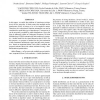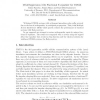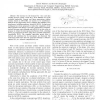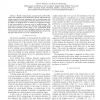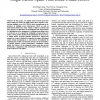ICASSP
2011
IEEE
12 years 8 months ago
2011
IEEE
In this paper, we tackle the problem of interference mitigation in ad hoc networks. In such context, the multiple access interference (MAI) is known to be of an impulsive nature. ...
TCOM
2010
12 years 11 months ago
2010
Two novel receiver structures which surpass the performance of the conventional matched filter receiver are proposed for ultra-wide bandwidth multiple access communications. The pr...
WINET
2010
13 years 2 months ago
2010
Connectivity in wireless ad hoc and sensor networks is typically analyzed using a graph-theoretic approach. In this paper, we investigate an alternative communication-theoretic app...
ETT
2002
13 years 4 months ago
2002
This paper deals with spreading sequences selection for downlink and uplink Multi-Carrier Code Division Multiple Access (MC-CDMA) systems with the aim of minimizing the dynamic ran...
ISICT
2003
13 years 5 months ago
2003
Wideband CDMA systems with orthogonal spreading codes suffer severely due to the loss of orthogonality by multipath propagation. This yields Multiple Access Interference (MAI) wh...
VTC
2006
IEEE
13 years 10 months ago
2006
IEEE
— The increase in the demand for voice and data wireless services creates a need for a more efficient use of the available bandwidth. Current and future generations cellular sys...
GLOBECOM
2006
IEEE
13 years 10 months ago
2006
IEEE
— Mobile communication systems based on DS-CDMA suffer from multiple access interference (MAI), which limits the system capacity. Several techniques, such as beamforming with mul...
ICC
2007
IEEE
13 years 10 months ago
2007
IEEE
—Two novel receiver structures which surpass the performance of the conventional matched filter receiver are proposed for ultra-wide bandwidth multiple access communications. Th...
ICC
2007
IEEE
13 years 10 months ago
2007
IEEE
—In this paper, we employ time-reversal space-time block coding (TR-STBC) in single-carrier direct sequence codedivision multiple access (DS-CDMA) block transmission in the prese...
VTC
2008
IEEE
13 years 11 months ago
2008
IEEE
Abstract—This paper studies the effect of Multiple access interference (MAI) on the performance of coded FHSS systems. This is achieved by modelling the physical channel in these...
